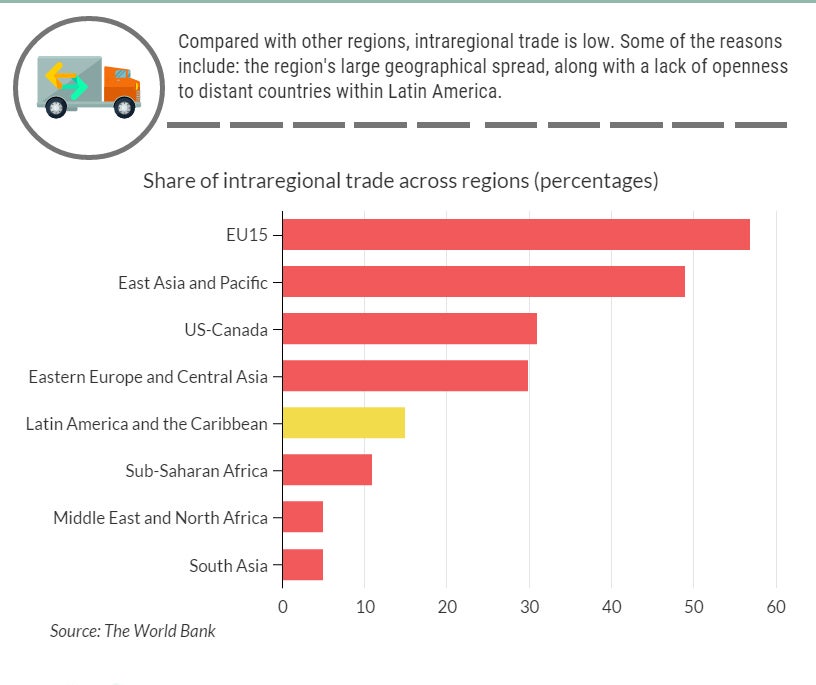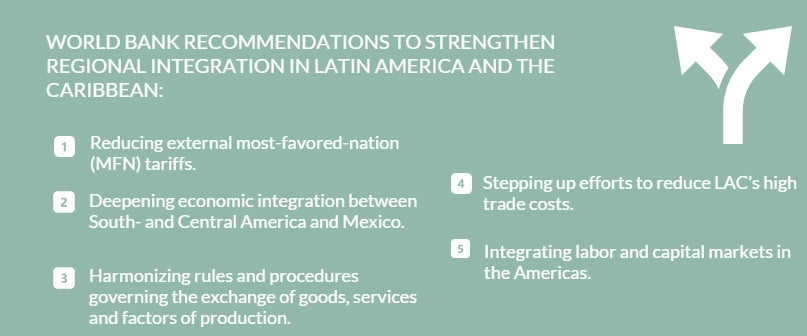By the time this blog pops up on your Twitter feed, mobile device or desktop, you will probably have heard seen or heard #integration, far too many times, presented as a strategy for economic renewal.
But before you hit ‘delete’ by my bringing up ‘integration’ yet again, bear with me.
Granted, integration is not a new concept for the region or even the world.
Latin America has been pursuing regional integration at least since the 1960s, stepping up efforts from the mid-1990s onward, which resulted in more trade agreements and lower tariffs. Before 2000, the average Latin American country held preferential trade agreements with about 4 regional partners; by 2013 these had increased to almost 10.
In addition, over three-quarters of Latin Americans favor closer integration with the world and neighboring countries, according to the latest survey by public opinion powerhouse Latinobarómetro.
Despite these pro-integration efforts and sentiments, the percentage of intraregional exports in the region’s total output has remained historically at roughly 20 percent –a stark contrast with East Asia Pacific where intraregional exports account for half of all trade. Take a look at this chart with inputs from 2014.

Now, this shouldn’t be a case of just keeping up on a global scale. Regional integration is not an end in itself, but a strategic tool to boost economic growth, and to keep raising the standards of living for all Latin Americans.
After six years of low economic growth, including two years of contraction, the region is in recovery mode.
And if the great social transformation of the past decade is to be preserved, it’s important that Latin America finds its footing. This is where ‘integration’ comes in. In our view, it’s an essential part of any plan for a sustained economic revival. As we argue in the just-released report Better Neighbors: Toward a Renewal of Economic Integration in Latin America, the region would be better off pursuing a more robust regional integration with the ultimate goal of becoming more competitive globally.
Indeed, regional integration has already moved to the forefront of the policy debate, and efforts like the Pacific Alliance (Colombia, Chile, Mexico and Peru) and new ties between this alliance and Mercosur (Argentina, Brazil, Paraguay and Uruguay) are welcome steps in the right direction.
But the path to greater integration is paved with challenges.
Some can be patently evident to anyone traveling in the region. Over 70 percent of Latin America’s road network is unpaved, which increases the costs of trade.
Additionally, ports and airports function in a complex hub-and-spoke operating structure making shipments less efficient. In the most recent Liner Shipping Connectivity Index, which measures the ease of access to high capacity maritime transport systems, only one Latin American country –Panama- grabbed a spot in the top 30 ranking of countries.
All in all, there is significant scope for further tariff liberalization. The average Latin American country currently levies an 8 percent tariff to its trading partners, well below the 12 percent tariff assessed in the mid-1990s. But exporters still face trade costs that are twice as high as in East Asia and Pacific countries.
These seem to stem from high transportation costs linked to infrastructure deficits (such as the ones described above). They are also the result of poor regulatory harmonization which can make the passage of cargo between borders less efficient.
Benefits would not only consist in lowering trade barriers, but perhaps more importantly, such a move would open up opportunities to greater productivity.
Consider, for example, the potential to create economies of scale. Greater integration among small countries, such as the Caribbean island states, would provide opportunities to access larger economies and become more competitive, something that they do not have today.
Consider also the potential to take full advantage of already significant advances in energy integration, harmonizing regulatory standards.
To put it simply, regulation could, for example, encourage exchanges of electricity between Central American countries, resulting in a more reliable and less expensive energy source for all. Take a quick look at some of the report’s recommendations:

Obviously, reducing tariffs alone is not enough.
The growth potential of deeper integration will depend on joint actions that feature three main characteristics: creativity, long-term vision and coordination between countries.
Above all, actions and policies should lean heavily towards investing in our people and making sure that no one is left behind. Key among these is improving the quality of public education so that Latin Americans have the skills the 21st century job market requires.


Join the Conversation